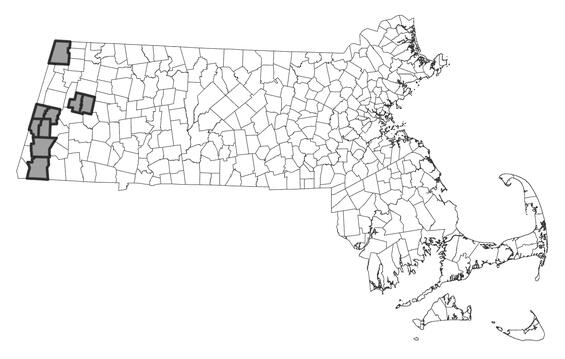- Scientific name: Conioselinum chinense (L.) Britton, Sterns & Poggenb
- Species of Greatest Conservation Need (MA State Wildlife Action Plan)
- Special Concern (MA Endangered Species Act)
Description
Hemlock-parsley, Conioselinum chinense, is a perennial herb in the parsley or angelica family (Apiaceae). It is generally a slender plant, growing to a height of 4-15 dm (1-5 ft) with a smooth, unspotted stem. The leaves are compound and highly dissected with short, broadly winged pedicels. Flowers are small, white, and occur in large flat clusters on an unbranched stem. Hemlock-parsley can be found in swamps, bogs, and wet meadows.
Hemlock-parsley’s distinctive leaves are smooth below, and pinnately compound (leaflets are arranged along a midrib). The leaves are twice- or thrice-cut, with highly dissected or lobed leaflets. The leaf blades are 10-20 cm long (4-8 in), while leaflets are 1.5-4.0 cm long (0.5-1.5 in), growing on elongated petioles. The small flowers have white petals but lack sepals; bracts are either narrow or lacking. The flowers are organized into umbels measuring 3-12 cm (1-5 in) in diameter, positioned at the tips of the stems. Hemlock-parsley blooms from July until September, producing two one-seeded mericarps (fruits), oblong or elliptical in shape, and flattened dorsally with corky, winged ribs.
Few members of the carrot family inhabit forested swamps in Massachusetts. Poison hemlock (Conium maculatum) is a coarse plant with highly dissected leaves and enlarged leaf bases. Flowers are white, occurring in umbels; bracts are entire, underneath the floral clusters. Poison hemlock has a smooth, spotted stem and reaches heights of 6-18 dm (24-72 in), growing commonly in waste places. It is poisonous and can be lethal when ingested. In drier places, Queen Anne’s lace is common along roadsides, and in dry meadows and waste places. Queen Anne’s lace or wild carrot (Daucus carota) has wide, flat umbels of white flowers, often with a single purple flower in the center. Stiff, three-forked bracts lie directly underneath the flower clusters, and above the highly dissected leaves. Stems are covered with bristly hairs and reach a height of 4-8 dm (12-36 in).
Life cycle and behavior
Hemlock-parsley blooms from July until September, producing two one-seeded mericarps (fruits), oblong or elliptical in shape, and flattened dorsally with corky, winged ribs.
Population status
Hemlock-parsley is currently listed as a species of special concern in Massachusetts. As with all species listed in Massachusetts, individuals of the species are protected from take (picking, collecting, killing, etc.) and sale under the Massachusetts Endangered Species Act. Eleven populations of hemlock-parsley have been verified since 1999. Two of those populations have numerous plants and are doing well. mst of the others have only scattered plants. There are an additional 11 populations that have not been recently observed. It has only been observed in Berkshire county.
Distribution and abundance
Hemlock-parsley is known in northeastern North America, including northeastern Canada and south to Missouri and Alabama. In New England, it is considered vulnerable in Massachusetts and Vermont, apparently secure in Connecticut, exotic in Maine and Rhode Island and not assessed in New Hampshire (NatureServe 2025).

Distribution in Massachusetts
1999-2024
Based on records in the Natural Heritage Database
Habitat
In Massachusetts, hemlock-parsley is usually found in swamps, wet meadows, bogs or fens, and marshy forests. It can tolerate shady environments and wet, acidic soils, although it is usually found in less acidic (circumneutral to limy) wetlands. It is often found in association with trees such as eastern hemlock (Tsuga canadensis), black ash (Fraxinus nigra), black spruce (Picea mariana), red maple (Acer rubrum), American larch (Larix laricinia), red oak (Quercus rubra), and yellow birch (Betula alleghaniensis). Other associated species include shrubby cinquefoil (Dasiphora floribunda), royal fern (Osmunda regalis), sheep laurel (Kalmia angustifolia), witch hazel (Hamamelis virginiana), bristly black currant (Ribes lacustre, Special Concern), and various species of sphagnum moss (Sphagnum spp.) and sedge (Carex spp.).
Healthy habitats are vital for supporting native wildlife and plants. Explore habitats and learn about conservation and restoration in Massachusetts.
Threats
Climate change may pose a significant threat to this species as the hydrology of its associated wet habitats may be affected by changing precipitation and temperature patterns (Staudinger et al. 2024).
Conservation and management
As for many rare species, exact needs for management of hemlock-parsley are not known. The following comments are based primarily on observations of populations in Massachusetts. Hemlock-parsley grows best in delicate environments, such as cold swamps and bogs, wet forests, and meadows. Any disturbance of these habitats, or change in the moisture regime or particular habitat, would negatively impact the populations. Wetlands such as swamps and bogs should be protected from disturbance and pollution, and an undeveloped buffer habitat should be maintained around these sensitive areas. Trail access to populations should be avoided, and where it occurs, efforts should be made to minimize trampling impacts.
References
NatureServe. 2025. NatureServe Network Biodiversity Location Data accessed through NatureServe Explorer [web application]. NatureServe, Arlington, Virginia. Available https://explorer.natureserve.org/. Accessed: 5/23/2025.
Staudinger, M.D., A.V. Karmalkar, K. Terwilliger, K. Burgio, A. Lubeck, H. Higgins, T. Rice, T.L. Morelli, A. D'Amato. 2024. A regional synthesis of climate data to inform the 2025 State Wildlife Action Plans in the Northeast U.S. DOI Northeast Climate Adaptation Science Center Cooperator Report. 406 p. https://doi.org/10.21429/t352-9q86
Contact
| Date published: | April 10, 2025 |
|---|